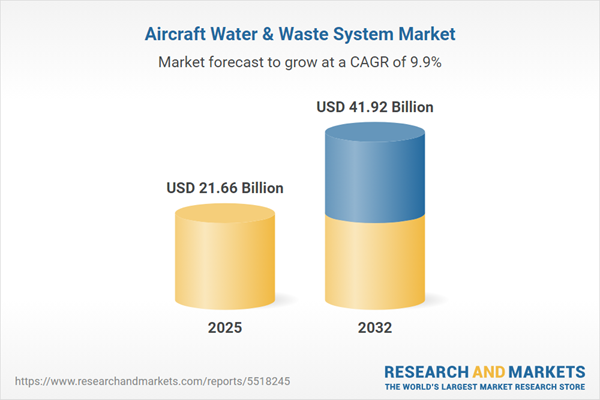Speak directly to the analyst to clarify any post sales queries you may have.
The aircraft water and waste system market is undergoing substantial transformation, shaped by new regulations, evolving technologies, and the increasing demand for operational resilience. Senior decision-makers need clear, actionable intelligence to navigate these changes, reinforce procurement strategies, and sustain compliance across aviation segments.
Market Snapshot: Aircraft Water and Waste System Market
Global demand for aircraft water and waste systems continues to accelerate, with the market estimated at USD 19.71 billion in 2024 and anticipated to reach USD 21.66 billion by 2025. Significant expansion is forecast, with values expected to climb to USD 41.92 billion in 2032. This anticipated compound annual growth rate of 9.89% is driven by advancements such as next-generation water filtration, digital system monitoring, and integrated onboard waste management. Efforts to comply with rising regulatory expectations and sustainability objectives push operators to adopt agile, future-ready solutions. Innovation is rapidly unfolding across commercial, business, and military aviation sectors, supporting the adoption of tailored technologies.
Scope & Segmentation
This report delivers a robust framework for senior leaders to analyze risks, seize opportunities, and optimize investments related to the aircraft water and waste system market. Detailed segmentation and technology trends inform greater adaptability, procurement clarity, and operational efficiency across a range of aviation activities.
- Aircraft Types: Business jets benefit from lightweight, seamlessly integrated systems prioritizing cabin function and passenger experience; narrow-body aircraft require space-efficient solutions; wide-body fleets adopt scalable technologies for long-range efficiency; regional operators value flexible system capabilities for diverse operational demands.
- System Types: Potable water innovations enhance storage security and filtration effectiveness for occupant safety, while vacuum waste systems improve onboard hygiene and continuous uptime in line with regulatory and user expectations.
- Service Types: Aftermarket solutions focus on modular retrofits and full lifecycle support, while manufacturing incorporates advanced systems at delivery to drive operational longevity and seamless integration.
- End Users: Airlines prioritize ease of maintenance and system uptime for fleet reliability; military end users select robust, compliant equipment; Maintenance, Repair, and Overhaul groups emphasize lifecycle extension and efficient replacement; VIP and charter operators invest in bespoke solutions for premium onboard experiences.
- Distribution Channels: Direct sales, diverse distributor partnerships, and digital procurement platforms contribute to global supply responsiveness and efficient systems delivery.
- Regional Markets: North America leads with modernization and effective logistics networks, Latin America transitions to more integrated systems, EMEA emphasizes energy efficiency and modularity, and Asia-Pacific applies predictive maintenance to maintain stability amid dynamic operational contexts.
- Leading Companies: Key players—including Collins Aerospace Inc., Parker-Hannifin Corporation, Safran SA, Honeywell International Inc., FACC AG, Jamco Corporation, and Stelia Aerospace SAS—actively shape system evolution and performance standards for the industry.
Key Takeaways for Senior Decision-Makers
- Digital diagnostics and predictive maintenance platforms drive consistent operational reliability, supporting fleet adaptability amid technology and policy shifts.
- Innovative onboard water recycling and advanced waste processing systems reinforce alignment with evolving sustainability mandates and support stronger ESG outcomes.
- Adoption of modular and flexible system architectures accelerates technology upgrades and increases operational resilience, enabling better fiscal management.
- Strategic collaboration between OEMs, technology vendors, and service providers advances rapid deployment of capabilities and strengthens system uniformity across platforms.
- Continual monitoring of compliance standards, supply chain reliability, and after-sales service maximizes readiness for procurement challenges and market transitions.
Tariff Impact on Aircraft Water and Waste System Supply Chains
Recent changes in U.S. tariffs are driving up expenses for water filtration components and system assemblies. In response, manufacturers are refining supplier diversity, repositioning inventories closer to strategic hubs, and boosting supply chain resilience to adapt to shifting trade conditions and support dependable stakeholder outcomes.
Methodology & Data Sources
Extensive research involves interviews with executives, technical analysis by OEM specialists, and direct airline feedback. Findings are validated through technical audits, public records, and compliance checks, delivering a rigorous and balanced perspective on the aircraft water and waste system market.
Why This Report Matters
- Enables senior leaders to align organizational strategy with regulatory shifts, technology change, and complex operator needs, driving the development of robust water and waste management frameworks.
- Delivers thorough regional segmentation and market analysis, equipping stakeholders to manage procurement, resource allocation, and risk effectively across all aviation sectors.
- Translates sustainability and compliance developments into strategic investment and operational decisions, fostering measurable improvements.
Conclusion
Armed with these insights, senior aviation teams can modernize processes, ensure compliance, and remain agile as new demands emerge. Leverage this intelligence to maintain operational strength and position your organization for future success.
Additional Product Information:
- Purchase of this report includes 1 year online access with quarterly updates.
- This report can be updated on request. Please contact our Customer Experience team using the Ask a Question widget on our website.
Table of Contents
3. Executive Summary
4. Market Overview
7. Cumulative Impact of Artificial Intelligence 2025
Companies Mentioned
The companies profiled in this Aircraft Water & Waste System market report include:- Collins Aerospace Inc.
- Parker-Hannifin Corporation
- Safran SA
- Honeywell International Inc.
- FACC AG
- Jamco Corporation
- Stelia Aerospace SAS
Table Information
| Report Attribute | Details |
|---|---|
| No. of Pages | 181 |
| Published | November 2025 |
| Forecast Period | 2025 - 2032 |
| Estimated Market Value ( USD | $ 21.66 Billion |
| Forecasted Market Value ( USD | $ 41.92 Billion |
| Compound Annual Growth Rate | 9.8% |
| Regions Covered | Global |
| No. of Companies Mentioned | 8 |









